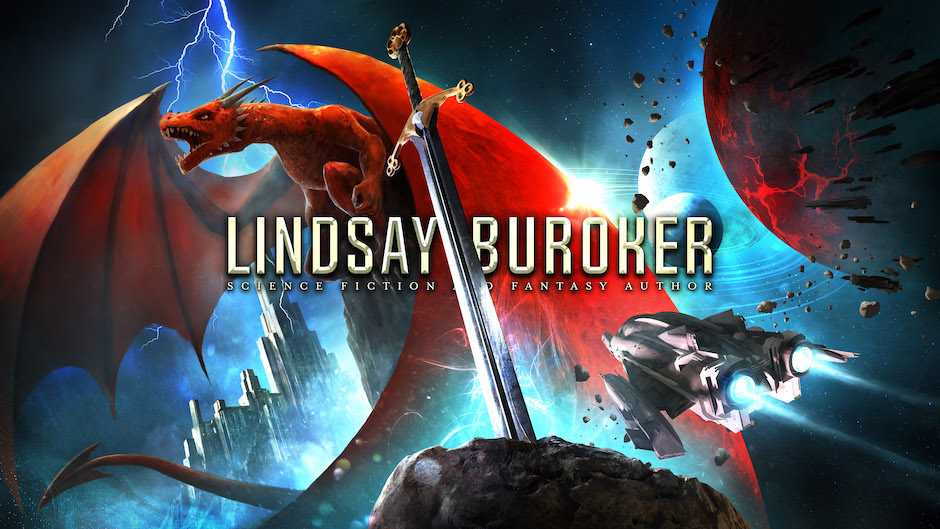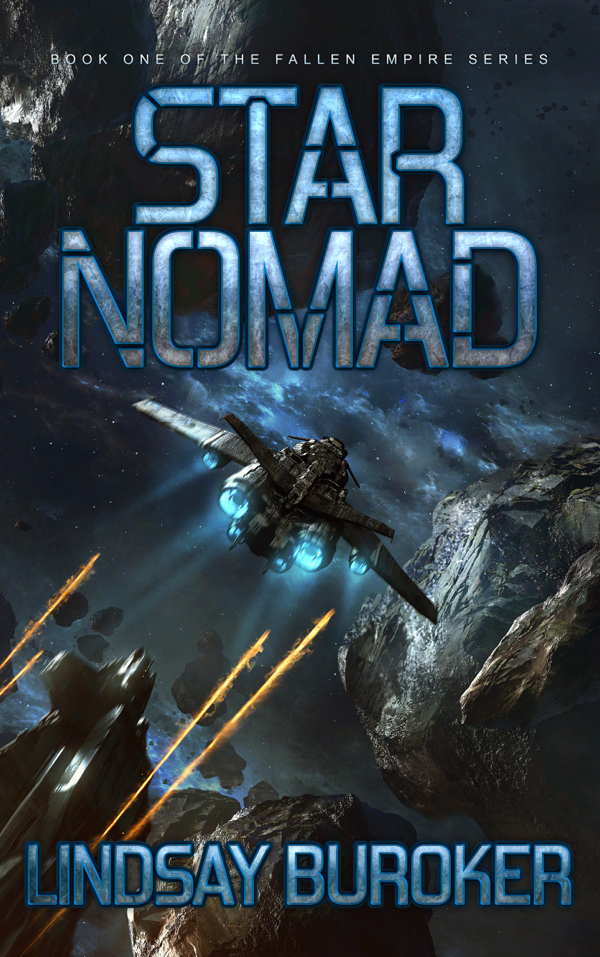I’ve been meaning to write up a post on my experience with using Kickstarter to fund publishing projects (in my case, an audiobook project), but I’m still busy getting together all the reward goodies for those who pledged, so I better wait until I have everything wrapped up. Fellow writer, John Portley, is running a campaign now, however, and offered to write a guest post. If you’re wondering if this might be a way to fund the start-up costs of getting your first manuscript online, then read on…
Is a Kickstarter Campaign a Consideration for You?
by John Portley
Being an author can be a lonely job, and in the transition to being a reasonably paying job, it can be a costly one. If one is going the indie route, then doing more than just creating an ebook can be a daunting concept. An author may want to create a special printing of her/his work, or to add numerous quality illustrations to a book before publication, or create an audio presentation of a novel, or to create another derivative of your work, such as a graphic novel. Hopefully the following regarding a particular way of asking for help in paying for such a project will help you in determining if this method is for you.
Hi, I’m John Portley, who will be publishing my first book later this year (Guardians of Pangea, Book1: The Worm in the Wood). I am here to share what I have learned in starting my Kickstarter campaign. Laying out some of the steps that I took should assist you in your deliberations of starting your own Kickstarter campaign, either now, or later in your career, to take advantage of crowd-funding, the term used for going to the masses to find funding for a particular mission, with Kickstarter.com being the number one website in the United States for assisting in such a goal (excluding charity sites).
Firstly, there are other websites with similar purposes to Kickstarter, with IndieGoGo being one that takes a lower percentage as their fee and is known to release the collected funds faster (Kickstarter and its partner will take about a collective 10% off the top, and can take 3 weeks to deliver the funds to your bank account after your campaign successfully ends). Though IndieGoGo is smaller in web traffic, you probably will be driving the majority of the traffic to your particular webpage, so taking a look at other crowd-funding sites should be a consideration.
For a discussion of crowd-funding websites, here is a good article.
Look to which sites apply to you, what each offers, and then charges, for hosting a crowd-funding webpage.
Incidentally, there will be an explosion of similar sites with the recent passing of a law that waters down the requirements for investors in a new company. Nearly anyone, from anywhere in the States, will soon be able to invest in a new business concept. Internet sites will spring up by the score, touting the Next Big Thing, telling you that you can be part of a cool company, and be a part owner in the next FaceBook, or Apple, or Twitter. Some great companies may be started this way, but I fear that this new law will multiply to ridiculous levels the boiler room stock pumping-and-dumping activities of fly-by-night companies. A strong warning for the future: beware.
But back to bringing your story’s project to the public. You will need to combine a bit of creative thought with a lot of rational thinking…
One of the first things to determine is exactly what you want to do. After all, what you will be doing is creating a contract between yourself and your sponsors. Set a specific monetary target for a clear goal—e. g., you will purchase X number of illustrations to go into your book, and will need Y number of dollars to do so, as well as pay for all the other aspects of the project. Do not set the monetary goal too high, because at Kickstarter, if the campaign does not generate enough pledged money to meet your goal, then none of the money comes to you. If your project has more money pledged than your goal, it all comes to you. Do not set the goal too low, as part of the milieu of crowd-funding is that the person asking for money will set up levels of support, and reward sponsors according to the level of support pledged. For example, if a sponsor pledges $25, then that person receives the book, postcards with illustrations from your book, and your thanks to this sponsor listed at your website. More rewards at higher levels of sponsorship. You have to factor in the costs of these rewards on the individual levels and within the overall project. These rewards must come out of the project itself, such as copies of your published book, or downloads of your audio interpretation of the book, or posters based on the illustrations which were paid for by the campaign.
I set my costs of the rewards at 40%-60% of the pledge amount, and that does not consider the sweat equity of designing, producing, and then delivering the items. Which brings up an important consideration: factor in the cost of having these items shipped to you, and then to your individual sponsors. The cost of shipping 100 posters to you in bulk may be $15, but cost $6—for a mailing tube and postage—for each of your pledge supporters. If you accept international donations, then figure out how to address international shipping, and its considerably higher costs.
To assist in telling your story about the campaign, Kickstarter strongly recommends that one creates a video, with the limit being 250 MB in size. Have your receipts ready for any licensed music used in your video if you also post this video to YouTube, as they have become sensitive about music rights (Kickstarter kindly lists a number of sources for licensing music at their website). It probably would not hurt to keep receipts for any copyrighted pictures used as well. Crowd-funding sites in general will probably be asking for all of these soon enough, in order to cover themselves legally.
My costs for the video were less than $500, though yours will probably be considerably lower, unless you hire a professional. The largest expense came from the three commissioned illustrations of characters from my book, something which you may not encounter for your project. I wanted to show the quality of the to-be-commissioned art for the book, so I paid for some before the campaign. I also paid for a few licensed illustrations from dreamstime.com and licensed music from JewelBeat.com (and some similar music also for my website). I purchased a video editing program. And though I just purchased an USB microphone (~$90) which is too late to use for this video, I am sure it will greatly improve my future ones, and strongly recommend using a separate microphone, and not your computer’s built-in ‘mike’.
Among the items to upload to your Kickstarter site is an image as the ‘face’ of your campaign, preferably in a 4 by 3 ratio (width by height, respectively). I took elements of my book cover, and rearranged them into a new picture. This gave continuity throughout the project—this new picture at Kickstarter, the book cover at my website, and some of the opening images in the video, all variations from the same illustration.
You will need a very short description of your project, and then a detailed description. The short is 135 characters of description. Mine was: “Guardians of Pangea is a family friendly series that explores a rich world of fantastical creatures and inventive individuals.” I still wonder how to spice up 135 characters, and this did nothing to talk about the goal of illustrations for the book, but it did describe the book itself…somewhat. For the long version, name drop if you can: the person(s) who will do the illustrations, the company that will produce the audio CD/download, or the printing house that you have arranged to do the special hardback collectible (and perhaps list similar works that this company has done). Show that you have planned ahead.
You will be asked to do a biography, which is something that I have always hated, but hopefully you are better at it than I. They also want a picture of you, which is something that even my own mother would be hard pressed to find, yet I hope that you are less shy than I. Then the address of your website, which is now nearly a requirement in this digital age, and for this I have no problem at all, for this is where I love to share details of my invented world.
You will need a banking account that will accept your funds, if and when they happen. I made mine a business account, as I am running my writing as an occupation, and involving the federal and state governments in its profits and expenses (the usual required partnership with the IRS and State Department of Revenue). The legalities in my state to set up such a business and then a business banking account actually took a little more than two months. I believe that a personal account will be acceptable to the Kickstarter campaign entities (named in the following paragraph).
Kickstarter uses Amazon to collect and distribute the funds of a successful campaign. So you will need to set up an Amazon Payments Account. Part of that process is that Amazon verifies your bank account, electronically if possible. My financial institution does not verify its bank accounts electronically (and I feel better that they do not), so Amazon plays a little game (PayPal does the same in their verification of a bank account, by the way). Amazon makes two sub-one dollar deposits into one’s bank account, then you access your account, electronically or in person, and report to Amazon what the exact deposits were. To save time, set up your account so that you can access it electronically, especially as Amazon can spread these two deposits across a number of days, and will not tell what those days will be. Also, part of the process at Amazon requires the filling out and signing a 1099 tax form, so that the government can track the money that your project may generate. Yes, there are frustrating delays everywhere, if you are not prepared.
And hopefully you are now more prepared, if you do want to run a crowd-funding campaign. There are at least two reasons to so: 1) the project itself; 2) the publicity for your work, whether or not the campaign financially succeeds. If you do run one, I wish you the best in both regards, and drop me a note at my website, I might be interested in what you are offering, or to answer questions about the process.
http://www.john-m-portley.com/
Please take a look around. My series has a broad age and genre appeal with its world of inventive people and devices, and dynamic characters who deal with friendship in the face of stress and conflict. A taste of the world and the series is at my website, including the first six chapters of Book 1 for your own enjoyment and judgment.
The video and webpage of my Kickstarter campaign is at:
http://www.kickstarter.com/projects/1922781115/guardians-of-pangea-book-1-kickstarter-campaign
…and there is even a button there to send the host (myself) a message, if you would care to remark on my project.
If you enjoy either, then please share, allowing your friends a chance to experience Guardians of Pangea. Perhaps you, they, or their friends, will be interested in the soon-to-released book and the colorful items that I am offering through the Kickstarter campaign, for themselves or as gifts to others.




Thank you for the information on Kickstarter. It seems like a lot of work but can be worth it if it pays off. Good luck with your campaign.
Thank you, Tara.
Some good fundamentals here. I would add that at its heart, kickstarter is a community – and in every conceivable sense, a social network.
Unless your strategy is 100% “product pre-sales” (make a widget and people get the widget when they pay retail), kickstarter is a direct, personal, social appeal connecting the *creator* with backers. You can have a great idea for a great series, but unless you reach out personally and make a social peer-to-peer connection, your project is unlikely to be funded, in my experience.
(That experience consists of trying to raise $4,000 for a single self-published book and resulting in over $91,000 for a series).
True. The subject of an article, or five, by itself.
A great resource for trying Kickstarter. Sounds like as much work as building an audience. Best on your release later this year, John.
Thank you much.